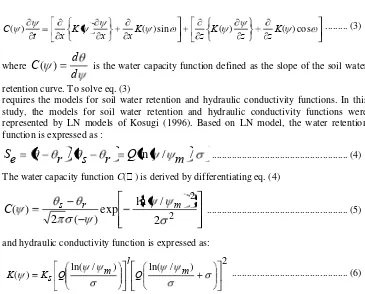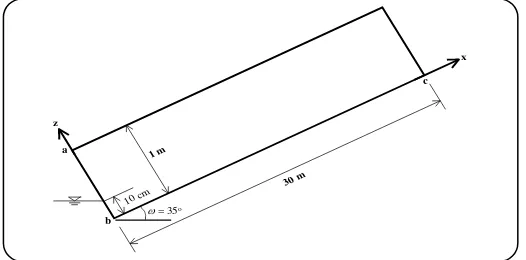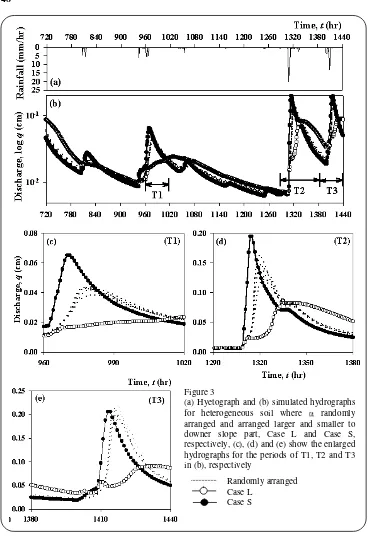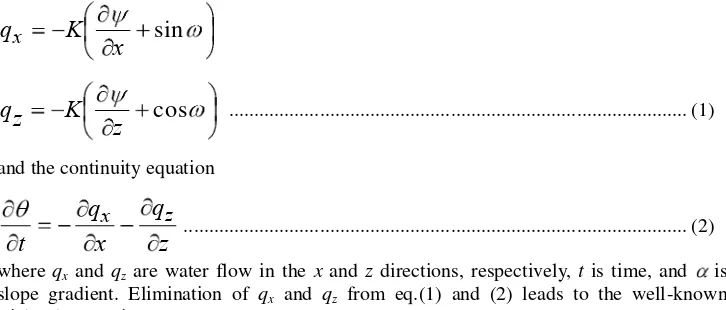Jurnal Manajemen Hutan Tropika Vol. 6 No. 1 : 43-50 (2000) Artikel (Article)
Trop. For. Manage. J. VI (1) : 43-50 (2000)
THE EFFECT OF VARIABILITY
IN SOIL HYDRAULIC PROPERTIES ON WATER FLOW IN A
FORESTED HILL SLOPE
Pengaruh Variabilitas Sifat-sifat Hidrolika Tanah Terhadap Aliran Air
di Lereng Berhutan
HENDRAYANTO1), KOSUGI KEN’ICHIROU2) & MIZUYAMA TAKAHISA2)
ABSTRAK
Pengaruh variabilitas sifat-sifat hidrolika tanah terhadap aliran air pada lereng berhutan dianalisis dengan menggunakan persamaan dua dimensi Richard secara numerik. Model fungsi-fungsi konduktivitas hidrolika dan retensi air digunakan model lognormal (Kosugi, 1996). Variabilitas sifat-sifat hidrolika tanah dievaluasi dengan menggunakan teori penyekalaan (scaling theory) (Hendrayanto, et al., 2000). Hasil penelitian menunjukkan bahwa penggunaan nilai rata-rata sifat hidrolika tanah cenderung memberikan nilai dugaan aliran air yang lebih rendah (under estimate). Pola penyebaraan faktor penyekala (scaling factor) mempengaruhi debit maksimum dan kurva resesi hidrograf. Makin besar faktor penyekala ke arah hilir lereng, debit maksimum makin lebih besar dan kurva resesi hidrograf makin curam, dan sebaliknya.
INTRODUCTION
The flow of water in the upper soil layer is a phenomenon encountered in various applications. Their modeling has been a subject of intense research. In a forested hillslope, the water flow phenomenon is very important for water resource management and predicting slope failure caused by heavy rainfall.
Forested hillslope is usually covered with forest soil, which has peculiar pore radius distribution and hydraulic properties. It has been frequently pointed out that the existence of large size pore increases the permeability of forest soil. This reduces the surface flow and increases the water infiltrates into soil profiles (Kirkby, 1978; Tsukamoto, 1992). The water flow studies in forested hill slope have been intensively done (Kubota et al.,1987; Ohta et al., 1983; Suzuki, 1984; Tsuboyama and Sammory, 1989; Sammory and Tsuboyama, 1990 etc.). Kosugi (1997) evaluated the effect of pore radius distribution on water flow. These studies applied a homogeneous soil, that is, the variability in soil hydraulic properties was not taken into consideration. However, forest soil shows high
1)Scientist & lecturer of on Laboratory of Forest InfluenceFaculty of Forestry, Bogor Agricultural
University Kampus IPB Darmaga, Bogor
variability in soil physical properties related to water flow phenomenon (Hendrayanto et al., 1999 and 2000).
The effect of variability in soil hydraulic properties on water budget of agricultural land has been studied extensively (Sharma and Luxmoore, 1979; Sharma et al. 1980; Hopmans and Sticker, 1989; Kim and Stricker, 1996; Kim et al., 1997). These studies showed that the water budget of the soil with the mean parameters was significantly different with the water budget of the soil with variable parameters.
Many approaches have been proposed to cope with the field variability for water flow simulation. One of them is to scale soil hydraulic properties according to the concept of similar media (Warrick et al, 1977, Sharma et al., 1980, Hopmans and Stricker, 1989). The attractiveness of the scaling theory lies in its potential to express spatial variability in terms of a single physically-based parameters. Using scaled hydraulic properties, the stochastic characteristics of spatial variability of hydraulic properties is described by the stochastic characteristics of scaling factors. Natural soils usually do not satisfy the strict similar-media requirement, and therefore the theory may have to be applied in an approximate form. Reichard et al. (1972) showed that laboratory-measured horizontal infiltration into soils having wide textural range could be scaled successfully. Hendrayanto et al., (2000) showed that water retention and hydraulic conductivity of forest soil could be scaled successfully by using the simultaneous method, in which the tortuosity parameter, l,was optimized (method 3b).
In this study, the effect of spatial variability in hydraulic properties on two dimensional water flow in a forested hillslope is evaluated.
THEORY
OF
TWO
DIMENSIONAL
WATER
FLOW
Figure 1 shows a schematic of a hillslope considered in this study. The two basic equations for water flow are Darcy-Buckingham law,
sin
x
K
q
xcos
z
K
z
q
... (1)and the continuity equation
z
q
x
q
t
z
x ... (2)
where qx and qz are water flow in the x and z directions, respectively, t is time, and is
slope gradient. Elimination of qx and qz from eq.(1) and (2) leads to the well-known
45 cos ) ( ) ( sin ) ( ) ( K z z K z K x x K x t
C ... (3)
where
d
d
C
(
)
is the water capacity function defined as the slope of the soil waterretention curve. To solve eq. (3)
requires the models for soil water retention and hydraulic conductivity functions. In this study, the models for soil water retention and hydraulic conductivity functions were represented by LN models of Kosugi (1996). Based on LN model, the water retention function is expressed as :
/
/
ln
/
s
r
Q
m
r
e
S
... (4)The water capacity function C() is derived by differentiating eq. (4)
2 2
2
/
ln
exp
)
(
2
)
(
s r mC
... (5)and hydraulic conductivity function is expressed as:
2 ) / ln( ) / ln( )
( Q m
l m Q
s K
K ... (6)
Equation (3) was combined with eq. (5) and eq. (6), and solved using Crank-Nicholson finite difference scheme. The domain having a size of 30 x 1 m (Fig. 1) was divided into 3000 elements. The size of each element was 30 x 10 cm. The slope gradient of the domain was 35 (Figure 1). The constant pressure head under the equilibrium condition with a 10 cm saturated zone was imposed to compute discharge at the outlet of the slope (a-b in Figure 1). At the bottom of soil profile and the upper boundary of the slope (b-c and c-d in Fig. 1), zero-flux condition was imposed. At the soil surface (a-d in Figure 1), natural rainfall was applied as the input for simulations. The initial condition was the hydraulic equilibrium with a limitation of the minimum pressure head of – 300 cm. The same rainfall condition was repeatedly used for two months and the latter half period was considered for analyses in order to eliminate the effects of initial conditions.
METHOD
30 m 1 m
10 cm
= 35o
a
c
z
x
b
obeys the lognormal distribution. The mean and the variance of ln were set to be equal to those obtained by Hendrayanto et al., (2000) the mean was 0 and the variance was 0.86.
Figure 1.Schematic hillslope as a domain applied in the simulations
RESULTS
Figure 2 shows the hydrograph for reference soil and 25 hydrographs for heterogeneous soils using 25 sets of randomly generated values. Figure 2c to 2e are enlarged hydrographs for the periods T1 to T3 in Figure 2b, respectively. In Figs. 2c and 2d, all hydrographs for heterogeneous soils (shown by dotted lines) had higher peak discharge rate than the hydrograph for the reference soil. In Figure 2e, the hydrographs for heterogeneous soils were scattered around the hydrograph for the reference soil, but mostly still lied above the hydrograph for the reference soil. That is, the reference soil parameters tend to underestimates storm water discharge, provided that the soil heterogeneity in nature is fully described by the randomly generated scaling factor distribution. By using a greater (black cyrcle hair line in Figure 2b), the hydrograph for the reference soil had larger peak discharge rate than the original hydrograph. On the contrary, a smaller value reduced the peak discharge rate (white cyrcle line in Figure 2b).
47
Figure 2
(a) Hyetograph and (b) simulated hydrographs for original reference soil ( =0.927), reference soil with =0.742 and =1.112, and twenty-five heterogeneous soils. (c), (d) and (e) show the enlarged hydrographs for the periods of T1, T2 and T3 in (b), respectively.
=0.927 (original reference) =0.742
=1.112
Figure 3
(a) Hyetograph and (b) simulated hydrographs for heterogeneous soil where randomly arranged and arranged larger and smaller to downer slope part, Case L and Case S, respectively, (c), (d) and (e) show the enlarged hydrographs for the periods of T1, T2 and T3 in (b), respectively
Randomly arranged Case L
49
CONCLUSIONS
Most of the twenty-five hydrograps for heterogeneous soils using randomly generated scaling factors had larger peak discharge rate than the hydrograph for the reference soil. This indicated that reference parameters tend to underestimate storm water discharge.
The effect of the scaling factor arrangement was significant; when the scaling factors were larger in the lower slope part, the peak discharge rate was higher, and vice versa.
LITERATURES
CITED
Hendrayanto, Kosugi, K., T. U., Sakiki Matsuda, and T. Mizuyama, 1999. Spatial variability of soil hydraulic properties in a forested hillslope. J. For. Res. 4:107-114. Hendrayanto, Kosugi, K. and T. Mizuyama, 2000. Scaling hydraulic properties of forest
soils. Hydrological Process. 14:521-5387
Hopmans, J.W. and J.N.M. Stricker, 1989 Stochastic analysis of soil water regime in a watershed. Forest Hydrol. 105:57-84
Kim, C.P., J.N.M. Stricker and R.A. Feddes, 1997. Impact of soil heterogeneity on the water budget of the unsaturated zone. Water Resour. Res. 33(5): 991-999.
Kim, C.P. and J.N.M. Stricker, 1996. Influence of spatially variable soil hydraulic properties and rainfall intensity on the water budget. Water Resour. Res. 32(6): 1699-1712.
Kirkby, M.J., 1978. Hillslope hydrology. 389pp, John Wiley and Sons, Norwich.
Kosugi, K., 1996. Lognormal distribution model for unsaturated soil hydraulic properties. Water Resour. Res. 32:2697-2703.
Kosugi, K., 1997. Effect of pore radius distribution of forest soils on vertical water movement in soil profile. J. Japan Soc. Hydrol.&Water Resour. 10(3):226-237 Kubota, J., Y. Fukushima and M. Suzuki, 1987. Observation and modeling of the run-off
process on a hill slope. J. Jpn. For. Soc. 69: 258-269 (in Japanese with English Summary)
Ohta, T., Y. Fukushima and M. Suzuki, 1983. Research from run off from hillsides by one-dimensional transient saturated-unsaturated flow. J.Jpn.For.Soc., 65:125-134 (in Japanese with English summary).
Reichardt, K., D.R. Nielsen and J.W. Bigger, 1972. Scaling of horizontal infiltration in homogeneous soils. Soil Sci. Soc. Am. Proc., 36: 241-245.
Sammori, T. and Y. Tsuboyama, 1990. Study on method of slope stability considring infiltration phenomenon. J. Jpn. Soc. Erosion Control Eng. 43(4): 14-21 (in Japanese with English summary).
Sharma, M.L., G.A. Gander and C.G. Hunt, 1980. Spatial variability of infiltration in a watershed. J. Hydrol, 45: 101-122.
Suzuki, M., 1984. The properties of a base flow recession curve of small mountainous watersheds, I. Numerical analysis using the saturated-unsaturated flow model. J.Jpn.For.Soc., 66:174-182 (in Japanese with English summary).
Tsuboyama, Y. and T. Sammory, 1989. Numerical simulation of seepage in a forested hillslope by finite element method. J.Jpn.Soc.Hydrol.Water Resour., 2(2), 49-56 (in Japanese with English Summary)
Tsukamoto, Y., 1992. Forest hydrology. 319pp, Buneido, Tokyo (in Japanese).
Jurnal Manajemen Hutan Tropika Vol. 6 No. 1 : 43-50 (2000) Artikel (Article)
Trop. For. Manage. J. VI (1) : 43-50 (2000)
THE EFFECT OF VARIABILITY
IN SOIL HYDRAULIC PROPERTIES ON WATER FLOW IN A
FORESTED HILL SLOPE
Pengaruh Variabilitas Sifat-sifat Hidrolika Tanah Terhadap Aliran Air
di Lereng Berhutan
HENDRAYANTO1), KOSUGI KEN’ICHIROU2) & MIZUYAMA TAKAHISA2)
ABSTRAK
Pengaruh variabilitas sifat-sifat hidrolika tanah terhadap aliran air pada lereng berhutan dianalisis dengan menggunakan persamaan dua dimensi Richard secara numerik. Model fungsi-fungsi konduktivitas hidrolika dan retensi air digunakan model lognormal (Kosugi, 1996). Variabilitas sifat-sifat hidrolika tanah dievaluasi dengan menggunakan teori penyekalaan (scaling theory) (Hendrayanto, et al., 2000). Hasil penelitian menunjukkan bahwa penggunaan nilai rata-rata sifat hidrolika tanah cenderung memberikan nilai dugaan aliran air yang lebih rendah (under estimate). Pola penyebaraan faktor penyekala (scaling factor) mempengaruhi debit maksimum dan kurva resesi hidrograf. Makin besar faktor penyekala ke arah hilir lereng, debit maksimum makin lebih besar dan kurva resesi hidrograf makin curam, dan sebaliknya.
INTRODUCTION
The flow of water in the upper soil layer is a phenomenon encountered in various applications. Their modeling has been a subject of intense research. In a forested hillslope, the water flow phenomenon is very important for water resource management and predicting slope failure caused by heavy rainfall.
Forested hillslope is usually covered with forest soil, which has peculiar pore radius distribution and hydraulic properties. It has been frequently pointed out that the existence of large size pore increases the permeability of forest soil. This reduces the surface flow and increases the water infiltrates into soil profiles (Kirkby, 1978; Tsukamoto, 1992). The water flow studies in forested hill slope have been intensively done (Kubota et al.,1987; Ohta et al., 1983; Suzuki, 1984; Tsuboyama and Sammory, 1989; Sammory and Tsuboyama, 1990 etc.). Kosugi (1997) evaluated the effect of pore radius distribution on water flow. These studies applied a homogeneous soil, that is, the variability in soil hydraulic properties was not taken into consideration. However, forest soil shows high
1)Scientist & lecturer of on Laboratory of Forest InfluenceFaculty of Forestry, Bogor Agricultural
University Kampus IPB Darmaga, Bogor
variability in soil physical properties related to water flow phenomenon (Hendrayanto et al., 1999 and 2000).
The effect of variability in soil hydraulic properties on water budget of agricultural land has been studied extensively (Sharma and Luxmoore, 1979; Sharma et al. 1980; Hopmans and Sticker, 1989; Kim and Stricker, 1996; Kim et al., 1997). These studies showed that the water budget of the soil with the mean parameters was significantly different with the water budget of the soil with variable parameters.
Many approaches have been proposed to cope with the field variability for water flow simulation. One of them is to scale soil hydraulic properties according to the concept of similar media (Warrick et al, 1977, Sharma et al., 1980, Hopmans and Stricker, 1989). The attractiveness of the scaling theory lies in its potential to express spatial variability in terms of a single physically-based parameters. Using scaled hydraulic properties, the stochastic characteristics of spatial variability of hydraulic properties is described by the stochastic characteristics of scaling factors. Natural soils usually do not satisfy the strict similar-media requirement, and therefore the theory may have to be applied in an approximate form. Reichard et al. (1972) showed that laboratory-measured horizontal infiltration into soils having wide textural range could be scaled successfully. Hendrayanto et al., (2000) showed that water retention and hydraulic conductivity of forest soil could be scaled successfully by using the simultaneous method, in which the tortuosity parameter, l,was optimized (method 3b).
In this study, the effect of spatial variability in hydraulic properties on two dimensional water flow in a forested hillslope is evaluated.
THEORY
OF
TWO
DIMENSIONAL
WATER
FLOW
Figure 1 shows a schematic of a hillslope considered in this study. The two basic equations for water flow are Darcy-Buckingham law,
sin
x
K
q
xcos
z
K
z
q
... (1)and the continuity equation
z
q
x
q
t
z
x ... (2)
where qx and qz are water flow in the x and z directions, respectively, t is time, and is
slope gradient. Elimination of qx and qz from eq.(1) and (2) leads to the well-known
45 cos ) ( ) ( sin ) ( ) ( K z z K z K x x K x t
C ... (3)
where
d
d
C
(
)
is the water capacity function defined as the slope of the soil waterretention curve. To solve eq. (3)
requires the models for soil water retention and hydraulic conductivity functions. In this study, the models for soil water retention and hydraulic conductivity functions were represented by LN models of Kosugi (1996). Based on LN model, the water retention function is expressed as :
/
/
ln
/
s
r
Q
m
r
e
S
... (4)The water capacity function C() is derived by differentiating eq. (4)
2 2
2
/
ln
exp
)
(
2
)
(
s r mC
... (5)and hydraulic conductivity function is expressed as:
2 ) / ln( ) / ln( )
( Q m
l m Q
s K
K ... (6)
Equation (3) was combined with eq. (5) and eq. (6), and solved using Crank-Nicholson finite difference scheme. The domain having a size of 30 x 1 m (Fig. 1) was divided into 3000 elements. The size of each element was 30 x 10 cm. The slope gradient of the domain was 35 (Figure 1). The constant pressure head under the equilibrium condition with a 10 cm saturated zone was imposed to compute discharge at the outlet of the slope (a-b in Figure 1). At the bottom of soil profile and the upper boundary of the slope (b-c and c-d in Fig. 1), zero-flux condition was imposed. At the soil surface (a-d in Figure 1), natural rainfall was applied as the input for simulations. The initial condition was the hydraulic equilibrium with a limitation of the minimum pressure head of – 300 cm. The same rainfall condition was repeatedly used for two months and the latter half period was considered for analyses in order to eliminate the effects of initial conditions.
METHOD
30 m 1 m
10 cm
= 35o
a
c
z
x
b
obeys the lognormal distribution. The mean and the variance of ln were set to be equal to those obtained by Hendrayanto et al., (2000) the mean was 0 and the variance was 0.86.
Figure 1.Schematic hillslope as a domain applied in the simulations
RESULTS
Figure 2 shows the hydrograph for reference soil and 25 hydrographs for heterogeneous soils using 25 sets of randomly generated values. Figure 2c to 2e are enlarged hydrographs for the periods T1 to T3 in Figure 2b, respectively. In Figs. 2c and 2d, all hydrographs for heterogeneous soils (shown by dotted lines) had higher peak discharge rate than the hydrograph for the reference soil. In Figure 2e, the hydrographs for heterogeneous soils were scattered around the hydrograph for the reference soil, but mostly still lied above the hydrograph for the reference soil. That is, the reference soil parameters tend to underestimates storm water discharge, provided that the soil heterogeneity in nature is fully described by the randomly generated scaling factor distribution. By using a greater (black cyrcle hair line in Figure 2b), the hydrograph for the reference soil had larger peak discharge rate than the original hydrograph. On the contrary, a smaller value reduced the peak discharge rate (white cyrcle line in Figure 2b).
47
Figure 2
(a) Hyetograph and (b) simulated hydrographs for original reference soil ( =0.927), reference soil with =0.742 and =1.112, and twenty-five heterogeneous soils. (c), (d) and (e) show the enlarged hydrographs for the periods of T1, T2 and T3 in (b), respectively.
=0.927 (original reference) =0.742
=1.112
Figure 3
(a) Hyetograph and (b) simulated hydrographs for heterogeneous soil where randomly arranged and arranged larger and smaller to downer slope part, Case L and Case S, respectively, (c), (d) and (e) show the enlarged hydrographs for the periods of T1, T2 and T3 in (b), respectively
Randomly arranged Case L
49
CONCLUSIONS
Most of the twenty-five hydrograps for heterogeneous soils using randomly generated scaling factors had larger peak discharge rate than the hydrograph for the reference soil. This indicated that reference parameters tend to underestimate storm water discharge.
The effect of the scaling factor arrangement was significant; when the scaling factors were larger in the lower slope part, the peak discharge rate was higher, and vice versa.
LITERATURES
CITED
Hendrayanto, Kosugi, K., T. U., Sakiki Matsuda, and T. Mizuyama, 1999. Spatial variability of soil hydraulic properties in a forested hillslope. J. For. Res. 4:107-114. Hendrayanto, Kosugi, K. and T. Mizuyama, 2000. Scaling hydraulic properties of forest
soils. Hydrological Process. 14:521-5387
Hopmans, J.W. and J.N.M. Stricker, 1989 Stochastic analysis of soil water regime in a watershed. Forest Hydrol. 105:57-84
Kim, C.P., J.N.M. Stricker and R.A. Feddes, 1997. Impact of soil heterogeneity on the water budget of the unsaturated zone. Water Resour. Res. 33(5): 991-999.
Kim, C.P. and J.N.M. Stricker, 1996. Influence of spatially variable soil hydraulic properties and rainfall intensity on the water budget. Water Resour. Res. 32(6): 1699-1712.
Kirkby, M.J., 1978. Hillslope hydrology. 389pp, John Wiley and Sons, Norwich.
Kosugi, K., 1996. Lognormal distribution model for unsaturated soil hydraulic properties. Water Resour. Res. 32:2697-2703.
Kosugi, K., 1997. Effect of pore radius distribution of forest soils on vertical water movement in soil profile. J. Japan Soc. Hydrol.&Water Resour. 10(3):226-237 Kubota, J., Y. Fukushima and M. Suzuki, 1987. Observation and modeling of the run-off
process on a hill slope. J. Jpn. For. Soc. 69: 258-269 (in Japanese with English Summary)
Ohta, T., Y. Fukushima and M. Suzuki, 1983. Research from run off from hillsides by one-dimensional transient saturated-unsaturated flow. J.Jpn.For.Soc., 65:125-134 (in Japanese with English summary).
Reichardt, K., D.R. Nielsen and J.W. Bigger, 1972. Scaling of horizontal infiltration in homogeneous soils. Soil Sci. Soc. Am. Proc., 36: 241-245.
Sammori, T. and Y. Tsuboyama, 1990. Study on method of slope stability considring infiltration phenomenon. J. Jpn. Soc. Erosion Control Eng. 43(4): 14-21 (in Japanese with English summary).
Sharma, M.L., G.A. Gander and C.G. Hunt, 1980. Spatial variability of infiltration in a watershed. J. Hydrol, 45: 101-122.
Suzuki, M., 1984. The properties of a base flow recession curve of small mountainous watersheds, I. Numerical analysis using the saturated-unsaturated flow model. J.Jpn.For.Soc., 66:174-182 (in Japanese with English summary).
Tsuboyama, Y. and T. Sammory, 1989. Numerical simulation of seepage in a forested hillslope by finite element method. J.Jpn.Soc.Hydrol.Water Resour., 2(2), 49-56 (in Japanese with English Summary)
Tsukamoto, Y., 1992. Forest hydrology. 319pp, Buneido, Tokyo (in Japanese).








